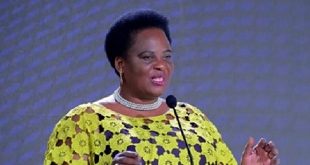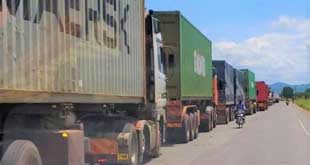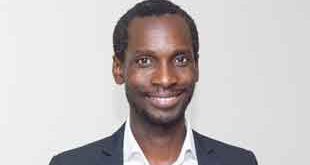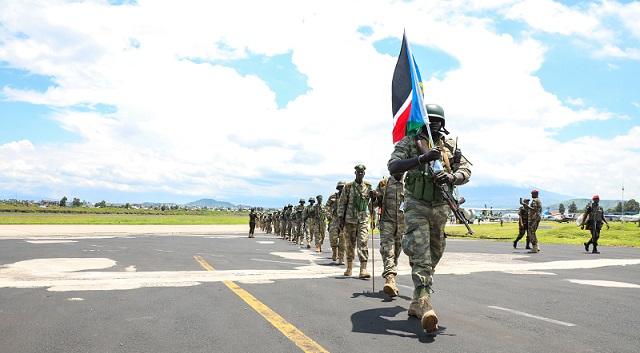
How mismatch in the regional force’s objectives and expectations of the Congolese government may render the failure of peace mission
COVER STORY | RONALD MUSOKE | Maj. Gen. Jeff Nyagah, the Kenyan Commander of the East African Community Regional Force (EACRF) has abruptly returned to Nairobi five months after landing in the eastern city of Goma with 900 troops of the Kenya Defence Forces (KDF).
In a leaked memo that circulated on social media in the evening of April 28, Maj. Gen. Nyagah cited “safety concerns” for his departure from the mission. The memo was addressed to Peter Mathuki, the Secretary General of the East African Community.
“Honourable Secretary as you are aware, there was an attempt to intimidate my security at my former residence by deploying foreign military contractors (mercenaries) who placed monitoring devices, flew drones and conducted physical surveillance of my residence in early January 2023 forcing me to relocate,” read Nyagah’s memo dated April 27.
Nyagah also cited “a well-coordinated and financed negative media campaign targeting his personality.” He said there had been claims of complacency on the part of the EACRF in relation to dealing with the M23 armed group, a rebel outfit that has been giving sleepless nights to Congolese President Félix Tshisekedi.
“Honourable Secretary General, there has also been a well-orchestrated and financed negative media campaign targeted at my personality and direct written false accusations of EACRF’s complacency on handling of the M23 group.”
Maj. Gen. Nyagah also pointed to the suspension of the EACRF’s Facebook account and a failure by Kinshasa to cater for the Force headquarters’ administrative costs, including electricity and civilian staff officers’ accommodation as sabotage to the force’s efforts.
“This is further enhanced by the current push by the government of the DRC to have the FC rotated every three (3) months which was not envisioned in the current mandate. Additionally, the recent suspension of the EACRF Facebook Account is an indication of possible sabotage of the Regional Force efforts.”
“This is equally compounded by the government of DR Congo failure to pay administrative cost including Force headquarters offices, staff officers’ accommodation, electricity as well as salaries for civilian staff as per Article 9 (c) and (d) of the Status of Force Agreement (SOFA).”
“Honourable Secretary General, it is with this in mind and further assessment that I have come to the conclusion that my security as the Force Commander is not guaranteed within the operation area. Further, the ongoing frustration has rendered my mission untenable to exit hence the precautionary decision to exit the mission area.”
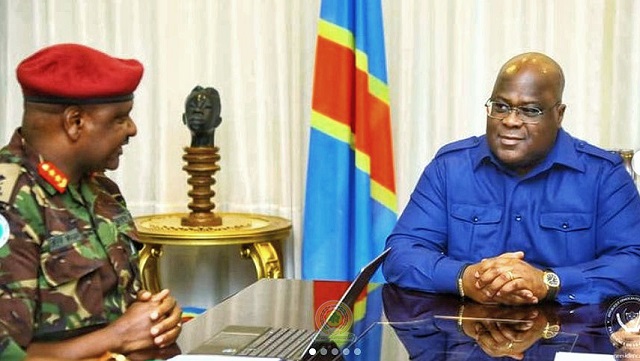
Interestingly, the Kenya Defence Forces (KDF) and the East African Community Secretariat dismissed the memo referring to its contents as “fake.” In the evening of April 28, the KDF tweeted: “Our attention is drawn to the fractitious letter with spurious claims.”
However, whether the memo was “fake” or not, what is clear is that Maj. Gen. Nyagah has returned to Nairobi and was immediately given a new assignment by President William Ruto in a mini reshuffle on April 28.
Upon the recommendation by the Defence Council, KDF said, President Ruto appointed Maj. Gen. Jeff Mungai Nyagah as the General Officer Commanding Western Command (GOC-WESTCOM) after a successful six-month tour as the first Force Commander, East African Community Regional Force (FC EACRF-DRC).
According to a statement from KDF, the EACRF will get a new commander (Maj. Gen. Alphaxard Muthuri) in the coming weeks but analysts that The Independent has spoken to say this will not mark the end of confrontation between Kinshasa and the regional force.
Stewart Muhindo, a Congolese researcher and activist affiliated to LUCHA, a non-violent, non-partisan civil society movement based in Goma told The Independent on April 30 that Nyagah’s exit from eastern DR Congo was shocking to him since just a few days earlier he had vowed “to die for peace in Congo.”
Muhindo told The Independent that Nyagah seemed determined to find a long-lasting solution to the insecurity in eastern DR Congo. He was at all times in touch with the Congolese government, civil society and rebel groups, telling them about EACRF’s mandate and why everyone had to give peace a chance, Muhindo said.
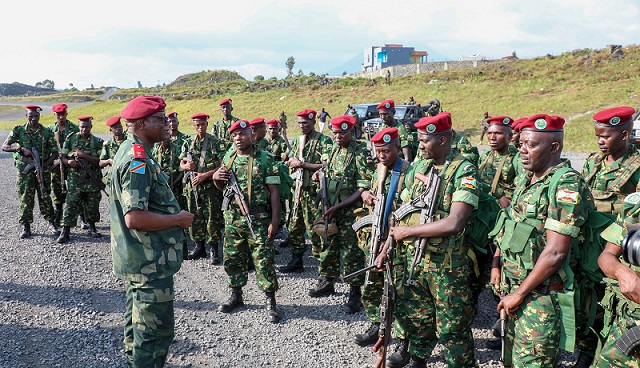
Yet, for Pecos Kulihoshi, a Goma-based civil society activist working with COJESKI, a refugee support organization, Maj.Gen. Nyagah’s resignation could be linked to his perceived proximity to the M23 rebels.
Kulihoshi told The Independent on April 30 that Maj.Gen. Nyagah was perceived by some in the Congolese government as too close to Rwanda and M23 to the point that he could not feel free to operate in North Kivu which made it difficult for him to coordinate the EACRF.
“His safety was already a challenge because the Congolese were suspicious of his collaboration with M23,” Kulihoshi said. Kulihoshi talks of a government affiliated youth wing known as Wazalendo that has recently organized in the North Kivu Province and are now part of the national reserve force. He said the youth wing fervently believes in the integrity of the Congolese state and that it has become so influential in North Kivu that Maj. Gen. Nyagah could have found it hard to move freely around Goma.
“He (Nyagah) could not defend the interests of the Congolese. He was becoming a ‘nuisance’ and it was becoming difficult for him. Here, the game is very simple: If you don’t have the interests of the Congolese people, you cannot operate,” Kulihoshi said.
“It’s not Nyagah alone. The same fate has befallen MONUSCO (UN peace keeping mission in DR Congo). If you are seen to take sides, you cannot operate here. The EACRF cannot succeed unless their mandate is made clearer. At the moment, the Force has a vague mandate.”
Kulihoshi added: “We don’t know what they came to do and when they try to communicate, they communicate different things and the Congolese people get lost and frustrated. The Congolese people for a long time have cried out for the M23 to be vanquished or leave the country. The EACRF says it didn’t come to fight; the DR Congo government says their mandate is to fight.”
Maj, Gen. Nyagah tour of duty
On Nov.12, last year, Kenyan soldiers landed in the city of Goma in eastern DR Congo as part of a regional military operation targeting rebels in the conflict-torn region. The arrival of the 900 Kenyan troops which followed approval by the Kenyan Parliament came as the M23 militia had surged across the DR Congo’s North Kivu Province.
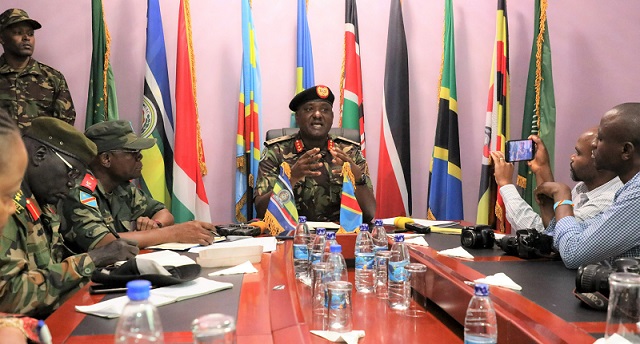
The inaugural Kenya continent (KENCON), troops under the East African Community Regional Force (EACRF) being deployed to the Democratic Republic of Congo (DR Congo) was flagged off by the Chief of Defence Forces, General Robert Kibochi at Embakasi Garrison.
The deployment came barely two weeks after President William Samoei Ruto, the Commander-in-Chief, presented the national flag to the troops, in which he urged them to fly high the Kenyan flag.
Speaking during the event, Gen. Kibochi was certain that the troops were mission ready after requisite training, affirming that they are prepared to execute the tasks as specified in the mandate. He further urged the troops to not only maintain discipline amongst themselves but further enhance good relations with the people of DR Congo and other peacekeepers operating in the country.
“You are the arrowheads, you are making history being the first team going on a peacekeeping mission under the East African Community, therefore, write a good one,” he said.
“Kenya has a good peacekeeping record and I hope you maintain the same. Politically and diplomatically, you are there for disarmament, demobilization and reintegration,” he said in a statement published on Kenya’s Ministry of Defence website.
Two months earlier, in September, Félix Antoine Tshisekedi, the president of the Democratic Republic of Congo presided over the signing of the agreement which gave the green light for the deployment of the EAC Joint Regional Force (EACRF). This force is supposed to be led by the Congolese national army—Forces Armées de la Republique Démocratique du Congo (FARDC).
Dr. Peter Mathuki, the East African Community Secretary General and Christophe Lutundula Apala Pen’Apala, DR Congo’s Vice Prime Minister and Minister of Foreign Affairs signed the Status of Forces Agreement (SOFA) at the official residence of the President in Kinshasa on Sept.9.
Dr. Mathuki noted that the agreement is in support of the implementation of the decision of the 22nd Summit of the EAC Heads of State to deploy a Joint Regional Force, to fight the negative forces.
“The Agreement envisages an initial deployment of the EAC Joint Regional Force for a period of six months after which the deployment will be evaluated,” the Secretary General noted. The SOFA outlines the obligations and responsibilities of the regional force while on DRC territory and the facilitation and support that will be granted by the DRC Government in line with the Constitution and applicable laws.
The Force Headquarters was also established and key personnel appointed. These include; EAC Force Commander Major General Jeff Nyagah from Kenya and one of the two deputies Brigadier General Emma Kaputa of the DR Congo.
South Sudan deploys 45 soldiers in DRC
Following the Kenya Defence Forces’ arrival in Goma, a Burundian contingent followed and on March 29, this year, the Uganda Peoples Defence Forces (UPDF) sent 5,000 troops for its long-awaited peace mission in the North Kivu Province of eastern DR Congo. Four days later, South Sudan dispatched 45 soldiers to Goma to join the regional military force. But this figure was way too short of the 750 troops South Sudanese President Salva Kiir promised last December. On March 15, Burundi sent more soldiers to Goma to buttress the EACRF’s military mission in eastern DR Congo.
But five months on, there seems to have been a change in attitude by the Congolese government towards the EACRF with some analysts saying there appears to be a misunderstanding of the regional force’s mandate. It is believed that many Congolese are unhappy with the regional leaders’ decision to prioritize non-military actions as reiterated by Mathuki during the AU event in Nairobi in January this year.
“Our intention is not to engage in combat or have our region at war, but to see how we all live in peace,” Mathuki said.
“The process in eastern DR Congo has to be solved through political processes, our military are there to reinforce the political process.”
Luanda agreement
Under the Luanda agreement signed in November 2022, DR Congo was tasked with disarming armed groups including the M23 and FDLR militia from Rwanda and ceasing hostilities. Meanwhile, the EAC heads of state have kept on reinforcing their commitment to nurture peace and security in eastern DR Congo using non-military means but Kinshasa has rejected all proposals for peace talks with the M23 rebels.
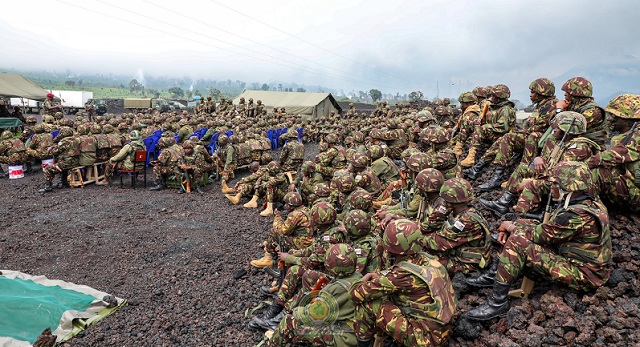
In recent months, there have also been protests in Goma over what locals say is the passivity of the regional troops. They want the troops to engage the armed rebel groups in the region, sentiments which have been echoed by some Congolese leaders.
“The East African Regional Force is slow to exercise the offensive mandate in support of the Congolese armed forces for which it EACRF was deployed,” said Christophe Mboso, Speaker of the National Assembly on March 15 at the opening of the Parliamentary session.
Mboso noted that the EACRF “offers a picture of troops on holiday in the Congolese theatre of operations. He expressed concern that the pressure of the EACRF troops on Congolese territory is becoming unnecessarily expensive.
In February this year, during an extraordinary summit of Heads of State held in Bujumbura, DRC President Felix Tshisekedi was captured on camera confronting Maj. Gen. Nyagah in the presence of President Ruto. A visibly angry Tshisekedi told Gen. Nyagah to fight M23 rebels or risk the wrath of the Congolese people.
“The objectives of EACRF and the expectations of the Congolese government are mismatched or misaligned,” Frederick Golooba-Mutebi, a political scientist and researcher told The New Times, a Kigali-based newspaper recently.
EACRF’s composition a problem for Congolese
Pecos Kulihoshi, told The Independent on April 30 that the deployment of the EACRF has never ever attracted the sympathy or even support of the Congolese people whether those in the east or those in Kinshasa or those in the Diaspora.
“The deployment of the EACRF never got any approval from the Congolese Parliament; it was only an initiative of the current government of President Tshisekedi,” Kulihoshi told The Independent. “The bottom line is that whether the EACRF is doing a good job or not, the Congolese have not appreciated their presence on Congolese soil.”
Muhindo also noted that Congolese citizens have a problem with the composition of EACRF. “The EACRF has countries which in the past participated in the destabilization of Congo. It’s very difficult for countries which have destabilized Congo to also be the same countries to bring solutions to the problem of insecurity in eastern DR Congo.”
“As you already know, we have had MONUSCO for many years in this country keeping peace but they have never succeeded. So, when the EACRF came we had the hope that they would confront the armed groups.
“But it turns out the EACRF is another MONUSCO and we think that it is impossible to let peace prevail by only agreeing on what rebel groups want. Even if they change the Commander of the EACRF I don’t think that will change the situation,” he added.
On May 1, the East African Secretariat came out via its Twitter handle to praise the EACRF saying the regional force has recorded many successes in its short mission in eastern DR Congo. The Secretariat noted that the force has continued to observe ceasefire and overseen the withdrawal of armed groups from most of the areas of occupation.
These areas include Karuba, Mushaki, Kilolirwe, Kitchange, Mweso, Kishishe, Bambo, Mnagana, Tchengerero, Kiwanja, and Kinyandoni. These areas have since been under the under the control of various EACRF contingents which will now enable residents to return to their homes and businesses.
“The EAC is proud of the work that has so far been accomplished by the EACRF towards restoration of peace and security in the eastern DR Congo,” the EAC Secretariat said.
“The EAC Secretariat therefore appeals to the East Africans and the international community to support the efforts by EACRF to restore peace and stability to eastern DR Congo. The EAC is fully committed to ensure restoration of peace and security in the eastern DR Congo and any other part of the region.”
Still, Dr. Solomon Asiimwe, a lecturer of governance at Uganda Martyrs University, Nkozi told The Independent on May 1 that he does not believe that the EACRF will do any wonders in Congo because there appears to be too many conflicting interests and relationships at play.
The only deployment that Dr. Asiimwe believe could do a good job in DR Congo is the Southern African Development Community (SADC). “It has a better chance than the EACRF because the rebels in DR Congo are too attached to East Africa, especially Uganda and Rwanda,” he said.
“I never expected the EACRF to fight because of the composition of the EACRF. Uganda and Rwanda both appear to have a soft spot for M23. So, when Uganda joins the EACRF, what are they going to do?”
Dr. Asiimwe noted that if the UN with all its logistical might has failed to pacify the region he doubts the EACRF can succeed. “This just goes to show that foreigners will never help Congo solve its internal problems,” he said.
Dr. Asiimwe said President Tshisekedi is understandably uncomfortable at the moment. He looks shaky and is anxiously waiting for an election this November this year. However, should that election go in his favour, Dr. Asiimwe said, Tshisekedi could call time on the EACRF in his country.
 The Independent Uganda: You get the Truth we Pay the Price
The Independent Uganda: You get the Truth we Pay the Price
